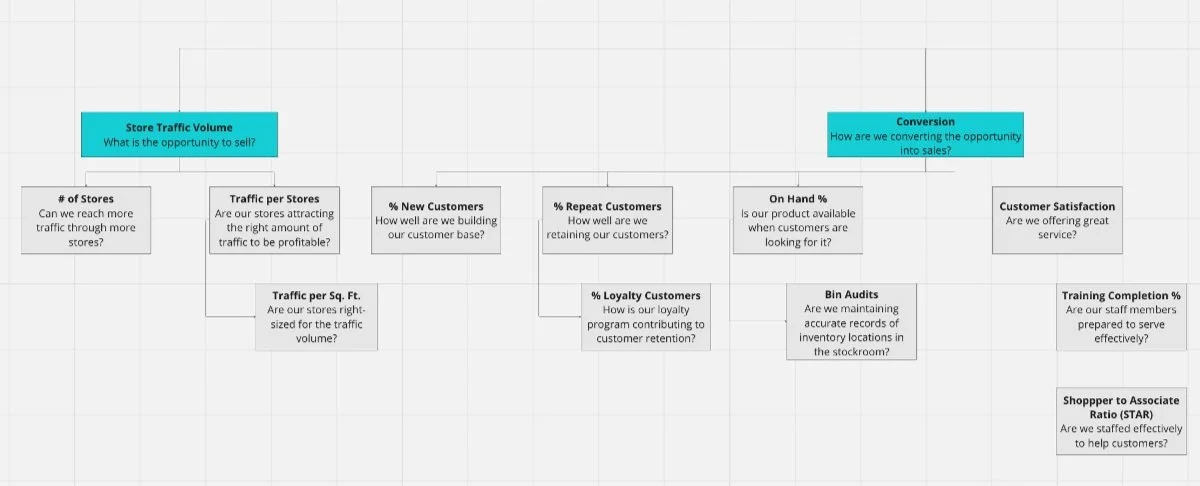Planting Seeds of Success: Grow Your Business with the Power of KPI Trees
On a daily basis, many of us slide into a comfy seat, drop our coffee thermos into its cup holder, press a few buttons, turn a few knobs, and before you know it we’re hurtling down the road singing “Life is a Highway” at the top of our lungs. OK, maybe not everyone is doing the “Life is a Highway” part.
Oftentimes, we’re running our businesses the same way. We’ve got a dashboard of KPIs (Key Performance Indicators) we get on Monday mornings to run our weekly business reviews. We debate. And then we go off to our individual teams to make adjustments. And maybe things change incrementally.
But running a business isn’t as simple as driving a car. It's more like piloting a commercial airliner. It’s not just about turning the key and hitting the gas; it's about managing a complex system where every team member plays a critical role. In aviation, a flight requires an army of people—pilots, flight attendants, mechanics, gate agents, air traffic control—all working in harmony towards a shared goal: a safe, timely journey for their passengers.
The Reality of Business: More Complex than It Seems
In theory, our businesses operate the same way. Multiple teams work together, each understanding their role in achieving a shared mission. But often, what might be a clear measure of success in the C-suite doesn’t translate well to deeper levels of the organization.
While high-level metrics like "conversion rate" are essential for executives, they don’t always connect with those on the ground. For example, someone might say they don’t use a metric like "conversion" because many factors influence it, making it hard to know if their work is the real driver. Yet, conversion is one of those KPIs that drive the weekly business review.
In response, teams might simply make up new, narrowly defined “KPIs” that ensure success for their specific initiative but don’t necessarily contribute to the overall success of the business.
The Need for a KPI Tree
If your organization has a hierarchy, so should your metrics. A KPI Tree is a multi-level, mathematically connected view of the building blocks of the business. It’s a critical tool that helps everyone understand how their work connects to higher-level metrics and, ultimately, the company’s success.
KPI Trees are a great way to connect the entire organization to the ultimate success metric while giving people at all levels a clear view of how their work connects to the ultimate success metric and to the work of other teams.
How do you build a KPI Tree?
Highest level view of a KPI Tree
Start with Your Core KPI:
Define the primary KPI that drives your business forward, whether it’s profit growth, customer satisfaction, or something else. This metric is your North Star.Break It Down:
Decompose that metric into key component parts that can be expressed mathematically. For example, in retail, profit growth might be broken down into Traffic, Conversion Rate, Average Order Value, and Profit per Transaction. These are some of the KPIs needed for the C-suite.Go Deeper:
Break each key driver into specific, measurable components that teams can influence.
Key guiding questions:
What actions do teams take that directly impact this driver?
Are these metrics within their control?
If this number moves, do teams know why?
Example: If one key driver is Conversion Rate, a breakdown might look like this:
Conversion Rate → Improving Customer Engagement
Marketing Team: “Are we attracting the right visitors?” → Ad click-through rate, landing page bounce rate
Sales Team: “Are we effectively engaging prospects?” → Lead response time, demo-to-close rate
Conversion Rate → Enhancing Checkout Experience
E-commerce Team: “Are we making it easy to buy?” → Cart abandonment rate, checkout completion rate
UX/UI Team: “Are there friction points in the buying process?” → Page load speed, form completion rate
Conversion Rate → Strengthening Customer Trust
Customer Support Team: “Are we addressing concerns before purchase?” → Pre-sale inquiry resolution time, live chat effectiveness
Brand & Content Team: “Are we building credibility?” → Product review volume, social proof impact
At each level, keep breaking it down until individual teams can directly connect their daily work to the metric. The goal is for every function—whether it’s sales, marketing, operations, or customer support—to see exactly how they influence key results.
Attach Questions:
For each metric, attach the question it’s meant to answer. For example, the metric "% Repeat Customers" might answer, "How well are we retaining our customers?" While these questions might sometimes seem obvious to you, they’re not always obvious to the teams doing the work. It’s worth being explicit.Continue to break down metrics as you can until you’re confident you’ve described the building blocks of the business to the degree that individual teams (or even individual people) can understand how their work is contributing to the total business.
Partial close-up view of a multi-level KPI Tree
One important consideration: determine whether a way you’re breaking down the business is actually a metric or a filter. The key here is to determine how unique from the rest of the tree a breakdown unit is. For example, Paid Traffic has a lot of profit impacts that organic doesn’t, so it would make sense for it to be a metric on the tree. But each category of your product might be more of a filter that runs across the whole tree and doesn’t need its own entry.
Why Embrace the KPI Tree?
A KPI Tree does more than just chart a course; it fosters a shared understanding and alignment within your company, turning individual efforts into a symphony of coordinated actions. It ensures that every team member, from the “mechanics” to the “pilots,” understands their role in the business’s success.
Embarking on the Journey as a Team
Constructing a KPI Tree is not a solitary endeavor but a collaborative voyage. Engage your team in its creation, validate its branches with real data, and be prepared to adjust your course as you gain insights.
By adopting a KPI Tree, you’re not just navigating the building blocks of your business; you’re setting a course for uncharted territories, armed with the clarity, unity, and direction needed to reach new heights of success.
In our businesses, as in aviation, the right tools, understanding, and teamwork make not just for successful flights but for extraordinary journeys. Let the KPI Tree be your guide across the vast skies of business possibilities, ensuring that every team member, regardless of their role, is aligned, informed, and motivated towards achieving the shared vision of your corporate odyssey.



